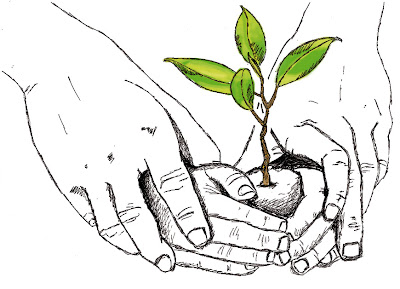![]()
Like killer tomatoes, drought tolerant tomatoes make sense, try dry farming your tomatoes. Dry farming tomatoes results into best flavor possible. To dry farm tomatoes we need to build the soil with organic matter with compost and growing cover crops. After planting tomatoes water them once and cover the ground in two layers of mulch. You could mulch your tomato beds with organic material and then with some hard mulch like gravel or bits of terracotta to prevent evaporation, and let the tomatoes grow without watering. You only water the tomatoes when their leaves start to turn yellow and then you do so rarely and deeply. Once the tomato plant develops fruit you stop watering all together. This allows the plant to focus not on new growth, but developing the fruit. You tomato plants will be ugly and straggly by doing this and your yield will be small, but you’ll have great tasting tomatoes. These sharp tasting tomatoes are perfect for sun dried tomatoes.
Thursday, May 13, 2010
Dry Farming Tomatoes
Sunday, May 9, 2010
Concept of Sustainable Living
Sustainable living refers to a lifestyle that attempts to reduce an individual's or society's use of the Earth's natural resources. Its also an attempt to reduce carbon footprints by altering methods of transportation, energy consumption and diet form furious consumptions to sensible choices. Sustainable and ecological living promotes living in manners that are consistent with sustainability, in natural balance and respect of humanity's symbiotic relationship with the Earth's natural ecology and cycles. The practice and general philosophy of Sustainable living is highly interrelated with the overall principles of Eco friendly development. Its also about minimizing our "ecological footprints to an extent that it dose not create an environmental impact. Proponents of Eco friendly living hope to preserve the Earth for future generations of human beings and other life.
Sustainable living branches from the concept of self-sufficiency. In recent years, its has been expressed as "development that meets the needs of the present without compromising the ability of future generations to meet their own needs. Self-sufficiency is the core principle of green living in which individuals or societies consume only that which they have produced.
Sustainable living demands environment friendly urban infrastructure in form of self sufficient design, which adheres to the principles of Eco friendly living. Its main principles are to achieve technological and governmental policies that enable urban planning for sustainable architecture and agriculture.
According to Lester R. Brown, a prominent environmentalist and founder of the World watch and Earth Policy Institutes, "Sustainable living in the 21st century is "shifting to a renewable energy-based, reuse/recycle economy with a diversified transport system."
There are many movements that oppose further mechanization of society vis-à-vis technological achievements. Eco consciousness, however, adheres to the belief that technological progress can be effectively achieved through appropriate technology.
There a many movements that may appear similar to sustainable living, which oppose further mechanization of society vis-à-vis technological achievements. Sustainable living, however, adheres to the belief that technological progress can be effectively achieved through appropriate technology.
Saturday, May 8, 2010
The Stinky Story of Deodorant

 Every one uses deodorants while knowing about the cancerous effects of deodorants on our body. Modern day deodorants have 7 deadly ingredients that should be avoided. While buying deodorant read the ingredients. Deodorants brands put them in very tiny print on the back of the Deodorant's can. Reading you deodorants ingredients is critical because what you put on your skin while using deodorants can be absorbed directly into your bloodstream & can have potentially deadly effects on your body.
Every one uses deodorants while knowing about the cancerous effects of deodorants on our body. Modern day deodorants have 7 deadly ingredients that should be avoided. While buying deodorant read the ingredients. Deodorants brands put them in very tiny print on the back of the Deodorant's can. Reading you deodorants ingredients is critical because what you put on your skin while using deodorants can be absorbed directly into your bloodstream & can have potentially deadly effects on your body.
Below are your 7 ingredients to avoid when choosing your deodorant:
Aluminum compounds from deodorants is absorbed through the skin and accumulates in the body. It has been suggested that there is an association between aluminum and Alzheimer's disease.
Parabens in deodorant are all derived from toluene, a toxic petrochemical derivative harmful in contact with the skin. There is some evidence that repeated exposure to toluene may cause reproductive harm. Since 2000, 13 research studies have shown that various types of parabens in our deodorants act like estrogen in animals and in tissue culture. Estrogen is known to drive the growth of cancerous cells.
Deodorants with Triclosan is a skin irritant and may cause contact dermatitis. It may kill healthy bacteria as well as harmful bacteria. It may contain carcinogenic contaminants. It is stored in body fat and is classified as a pesticide by the FDA.
Talc is classified as a carcinogen by the International Agency for Research on Cancer if it contains asbestiform fibers. The quantity of asbestiform fibers in cosmetic grade talc is unregulated. If talc is listed on the deodorant's label, there is no way of knowing whether or not it contains asbestiform fibers.
Propylene glycol absorbs from usage of deodorants is a penetration enhancers. It may cause delayed allergic reactions. NIOSH says propylene glycol is a neurotoxin and may cause kidney or liver damage. The EPA says it's not fully investigated for carcinogenic potential.
Silica in deodorant is a skin irritant. It may be contaminated with crystalline quartz, which is a carcinogen.
Steareth-n (n may be any number like say 100 in deodorants), may be vegetable derived but is reacted with ethylene oxide (ethoxylated), a known human carcinogen.
Very few herbs supplied to deodorant manufacturers are free of synthetic preservatives unless they are extracted in vegetable glycerin. To make sure that the products you buy are healthy and free of these harmful chemicals.
But I'm not hippy enough to stink :(
Choose deodorants with ingredients like vegetable glycerin, natural preservatives like bioflavanoids and lichen, herbs or herbal extracts, de-ionized water or distilled water, green tea, aloe vera, baking soda, Alum and essential oils. Better yet use these natural products directly and raw.....they workkkk.


Saturday, May 1, 2010
Journey Towards Green Vehicles

Seldom have we stumbled on to a viable solution at the first attempt, there are a number of possibilities which have so far been created and demonstrated within which we will be replacing the traditional petrol/diesel burning car. Just because a car is running on an alternate fuel does not necessary makes it a solution viable enough to replace the fossil fuel.
There are still a number of factors that will determine how efficiently we can manage resources. It is always wise to remember that there are no miracle cures to a century old ECO problems.
Alternate fuels which replaced fossil fuel in our fuel tanks so far are Electricity, Ethanol & Bio diesel, Hydrogen, kinetic energy, air & steam power...
Let's look at how alternate energy has been fighting its way into the tarry market of fossil fuel. kinetic energy, air & steam power:
kinetic energy, air & steam power:
Trams before WW2 were being run on air and steam engine. Paris operated trams that were powered by compressed air using the Mekarski system in 1876. These were replaced in 1911 by cheap fossil fuel based electricity which is now taking its toll on people of Paris with cost of producing electricity using Eco enemy fuels.....trams have been running on steam & kinetically powered engines as well in past. India has been working on Air engine and Tata intends to run taxis powered by air.
Image Above: A bouillotte mounted on the front of a tram built by Mékarski and used in early trials in Paris. (Drawing 1875)
Image Right:La Nature of a New York air loco 1882.
Image Below: German electric car, 1904, with the chauffeur on top. Electricity:
Electricity:
We all know that our vehicles can be driven on electricity but we  are not satisfied with the speed, but electricity is one of the greenest most Eco friendly options we have..provided electricity used for charging our plug-in's has been produced with renewable energy. Electric vehicles also seem to be the most commercially viable option at the moment.
are not satisfied with the speed, but electricity is one of the greenest most Eco friendly options we have..provided electricity used for charging our plug-in's has been produced with renewable energy. Electric vehicles also seem to be the most commercially viable option at the moment.
Image Right:The Henney Kilowatt, a 1961 production electric car.
Hydrogen: A hydrogen vehicle is an alternative fuel vehicle that uses hydrogen as its onboard fuel for motive power. The engines of such vehicles convert the chemical energy of hydrogen to mechanical energy either by burning hydrogen through internal combustion , or by reacting hydrogen with oxygen in a fuel cell to run electric motors.
A hydrogen vehicle is an alternative fuel vehicle that uses hydrogen as its onboard fuel for motive power. The engines of such vehicles convert the chemical energy of hydrogen to mechanical energy either by burning hydrogen through internal combustion , or by reacting hydrogen with oxygen in a fuel cell to run electric motors.
Hydrogen fuel does not occur naturally on Earth and thus is not an energy source, but is an energy carrier. Currently it is most frequently made from methane or other fossil fuels. However, it can be produced from a wide range of sources (such as wind, solar, or nuclear) that are intermittent, too diffuse or too cumbersome to directly propel vehicles. Hydrogen as fuel is not commercially viable..at the moment.
Ethanol & Bio diesel:
No good words for Ethanol and Bio diesel from me.... i hate the idea and find it utterly non  sustainable. in fact the impact of producing and using Bio diesel & Ethanol is a hundred times deadlier then fossil fuel. Firstly because it is produced from food..... making farming land and agriculture yet another highly captalistable industry....leading to even more food insecurity & deforestation......and lets not forget there are still fumes involved....
sustainable. in fact the impact of producing and using Bio diesel & Ethanol is a hundred times deadlier then fossil fuel. Firstly because it is produced from food..... making farming land and agriculture yet another highly captalistable industry....leading to even more food insecurity & deforestation......and lets not forget there are still fumes involved....
Our commitment with electric vehicles & mass transports like Maglev trains from Germany & Japan can lead us to cleaner, breathable future....
Blog Archive
- June (2)
- May (1)
- November (2)
- August (2)
- July (1)
- May (4)
- March (2)
- February (10)
- January (1)
- December (5)
- November (11)
- July (6)
- June (42)
- May (8)
- April (19)
- March (6)
- February (15)
- January (4)
- December (1)
- November (1)
- October (1)
- September (1)
- August (5)
- July (9)
- June (6)
- May (5)
- April (6)
- March (2)
- February (2)
